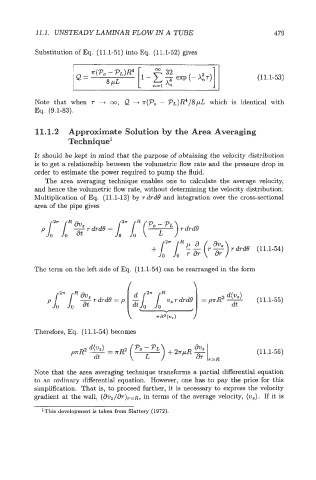Page 499 - Modelling in Transport Phenomena A Conceptual Approach
P. 499
11.1. UNSTEADY LAMINAR FLOWIN A TUBE 479
Substitution of e. (11.1-51) into Eq. (11.1-52) gives
(11.1-53)
Note that when r --f 00, Q --$ ..(Po - PL)@/S~L which is identical with
Eq. (9.1-83).
11.1.2 Approximate Solution by the Area Averaging
Technique1
It should be kept in mind that the purpose of obtaining the velocity distribution
is to get a relationship between the volumetric flow rate and the pressure drop in
order to estimate the power required to pump the fluid.
The area averaging technique enables one to calculate the average velocity,
and hence the volumetric flow rate, without determining the velocity distribution.
Multiplication of &. (11.1-13) by T drde and integration over the cross-sectional
area of the pipe gives
5
+I I Rpa ; (r2)rdrdQ (11.1-54)
2=
The term on the left side of Eq. (11.1-54) can be rearranged in the form
-
p J"^ IR % r drde = p [ $I2= Jd" w, r dr d 0) = pR2 - (11.1-55)
dt
d(wz)
0 0
nRa (v, )
Therefore, IZq. (11.1-54) becomes
(11.1-56)
Note that the area averaging technique transforms a partial differential equation
to an ordinary differential equation. However, one has to pay the price for this
simplification. That is, to proceed further, it is necessary to express the velocity
gradient at the wall, (awZ/ar),=R, in terms of the average velocity, (w,). If it is
'This development is taken from Slattery (1972).

